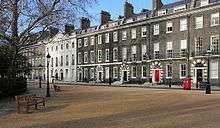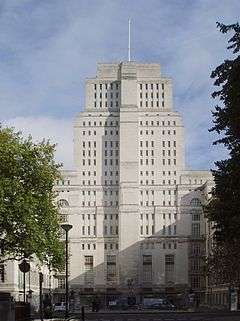Russell Square
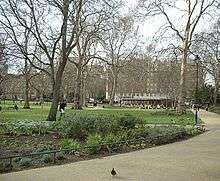
Russell Square is a large garden square in Bloomsbury, in the London Borough of Camden, built predominantly by James Burton. It is near the University of London's main buildings and the British Museum. To the north is Woburn Place and to the south-east is Southampton Row. Russell Square tube station is nearby to the north-east.
It is named after the surname of the Earls and Dukes of Bedford; the freehold remains with the Bedford Estate, though the square is managed by Camden Council. The gardens are Grade II listed on the Register of Historic Parks and Gardens.[1]
History
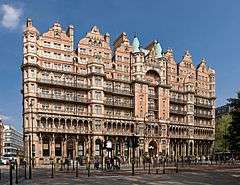
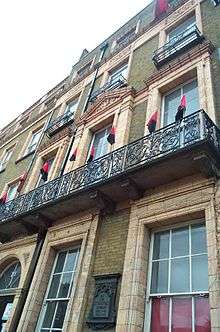
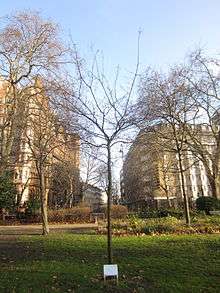
Following the demolition of Bedford House, Russell Square and Bedford Square were laid out in 1804.[2] The square is named after the surname of the Earls and Dukes of Bedford, who developed the family's London landholdings in the 17th and 18th centuries.[2] Thomas Lawrence had a studio at number 65 (1805–1830).[3] Other past residents include the famous 19th century architectural partnership of father and son, Philip and Philip Charles Hardwick who lived at number 60 in the 1850s.[4]

The Cabmen's Shelter Fund was established in London in 1875 to run shelters for the drivers of hansom cabs and later hackney carriages (and taxicabs).[5]
On the eastern side the Hotel Russell, built in 1898 to a design by Charles Fitzroy Doll, dominates (its builders were connected with the company which created RMS Titanic),[6] alongside the Imperial Hotel, built in 1966.[7]
The square contained large terraced houses aimed mainly at upper-middle-class families. A number of the original houses survive, especially on the southern and western sides. Those to the west are occupied by the University of London, and there is a blue plaque on one at the north west corner commemorating the fact that T. S. Eliot worked there from the late 1920s when he was poetry editor of Faber & Faber: a building now used by the School of Oriental and African Studies (a college of the University of London).[8]
In 1998, the London Mathematical Society moved from rooms in Burlington House to De Morgan House, at 57–58 Russell Square, in order to accommodate staff expansion.[9]
In 2002, the square was re-landscaped in a style based on the original early 19th century layout by Humphry Repton (1752–1818).[10]
Since 2004, the two buildings on the southern side, at numbers 46 and 47, have been occupied by the Huron University USA in London (now the London campus for EF International Language Centres and is the Centre for Professional Students over the age of 25).[11]
On 7 July 2005, two terrorist bombings occurred near the square. One of the bombings was on a London Underground train from King's Cross St Pancras tube station to Russell Square tube station, and another was on a bus on Tavistock Square, near Russell Square. To commemorate the victims, many flowers were laid at a spot on Russell Square just south of the café. The location is now marked by a memorial plaque and a young oak tree.[12]
At 52-53 Russell Square, is the Chartered Institute of Public Relations, which moved there in 2009.[13] The square was also the site of a mass stabbing in 2016.[14]
Literature and culture
- In the early chapters of Thackeray's Vanity Fair (1848), set c. 1812, Russell Square is evoked as the residence of the "John Sedley, Esquire, of Russell Square, and the Stock Exchange."[15]
- 21 Russell Square is the murderer's street address in the novel (but not in the movie adaptation) The Murderer Lives at Number 21 (L'Assassin habite au 21) by the Belgian writer Stanislas-André Steeman.[16]
- In John Dickson Carr's detective novel The Hollow Man, the victim, Professor Grimaud, lives in a house on the western side of Russell Square.[17]
- In Alan Hollinghurst's novel "The Swimming Pool Library" (1988) the protagonist William Beckwith spends time here with his lover who works in a hotel overlooking the square.[18]
- In Chapter 6 - Rendezvous of John Wyndham's novel "The Day of the Triffids" (1951) The main characters William (Bill) Masen and Josella Playton are photographed by Elspeth Cary in Russell Square while practicing with Triffid Guns.[19]
- Russell Square is the location of the eponymous bookshop in the Channel 4 sitcom Black Books.[20]
- In Ben Aaronovitch’s Peter Grant books, the first of which is The Rivers of London (AKA Midnight Riot), The Folly – headquarters of British wizardry – is located in Russell Square.[21]
- Virginia Woolf set many scenes of her novel Night and Day (1919) in Russell Square.[22]
See also
| Wikimedia Commons has media related to Russell Square. |
- List of eponymous roads in London
- Other squares of the Bedford Estate in Bloomsbury included:
References
- ↑ Historic England, "Russell Square (1000213)", National Heritage List for England, retrieved 11 April 2017
- 1 2 Walford, Edward (1878). "'Russell Square and Bedford Square', in Old and New London". London. p. 564-572. Retrieved 15 July 2018.
- ↑ "Lawrence's studios". National Portrait Gallery. Retrieved 15 July 2018.
- ↑ "Philip Hardwick (1792-1870)". Victorian Web. Retrieved 15 July 2018.
- ↑ "Cabman's shelters, London - Victorian survivors on London's streets". Urban75. 1 April 2006. Retrieved 15 July 2018.
- ↑ "'Titanic' hotel to celebrate £85m relaunch in Bloomsbury". Evening Standard. 15 February 2018.
- ↑ Hobhouse, Hermione (1972). Lost London ([1st American ed.] ed.). Boston: Houghton Mifflin. p. 207. ISBN 9780395135211.
- ↑ "T. S. Eliot brown plaque in London". Blue Plaques. Retrieved 15 July 2018.
- ↑ "About us". London Mathematical Society. Retrieved 15 July 2018.
- ↑ "How visionary designer Humphry Repton created the glorious squares of London". The Guardian. 25 March 2018. Retrieved 15 July 2018.
- ↑ "Huron University USA in London". Euro Education. Retrieved 15 July 2018.
- ↑ "News of the World 'hacked 7/7 family phones'". BBC News. 6 July 2011.
- ↑ "Office location". Chartered Institute of Public Relations. Retrieved 15 July 2018.
- ↑ Dewan, Angela; Berlinger, Joshua; Gigova, Radina (4 August 2016). "American killed in London knife attack, 5 others hurt". CNN. Retrieved 4 August 2016.
- ↑ William Makepeace Thackeray, Vanity Fair, Ch. 4.
- ↑ "No, the murderer doesn't live here... try number 21 in Paris". At the Scene of the Crime. 28 April 2012. Retrieved 15 July 2018.
- ↑ "The Hollow Man". Gadetection. Retrieved 15 July 2018.
- ↑ Hollinghurst, Alan (1988). The Swimming-pool Library. Chatto and Windus. ISBN 978-0701132828.
- ↑ "A literary London mash-up map". The Independent. 2 February 2014. Retrieved 15 July 2018.
- ↑ "Black BookS". IMDB. Retrieved 15 July 2018.
- ↑ "The Rivers of London". My Chronicle Book Box. Retrieved 15 July 2018.
- ↑ "Virginia Woolf: Night and Day". Literature Page. Retrieved 15 July 2018.
